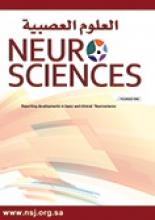Article Figures & Data
Tables
Indication Dose Pyridoxine (B6)-dependent epilepsy B6 15-30 mg/kg/d BID (up to 500 mg/day) or (50-100) mg IV with simultaneous EEG recording. Pyridoxal 5’-phosphate-dependent epilepsy Pyridoxal 5’-phosphate (30–50 mg/kg TID) Folinic acid-responsive seizures Folinic acid (3–5 mg/kg/dose) Biotinidase deficiency Biotin (10 - 20 mg/day) Biotin-thiamine-responsive basal ganglia disease Biotin (5–10 mg/kg/dose) and thiamine (300–900 mg/day) Cerebral creatine deficiency syndromes GAMT deficiency:
Oral creatine monohydrate (dosage of 400-800 mg/kg/day TID or more)
Ornithine: 100 mg/kg/day
AGAT deficiency:
Oral creatine monohydrate (dosage of 400-800 mg/kg/day TID or more)
CRTR deficiency:
Creatine monohydrate 100-200 mg/kg/day TID
Arginine 400 mg/kg/day TID
Glycine 150 mg/kg/day TIDGAMT - guanidinoacetate methyltransferase, AGAT - L-arginine:glycine amidinotransferase deficiency, CRTR - creatine transporter deficiency Medication Dose Riboflavin (B2) 50–400 mg po OD in children and 50–400 mg po OD in adults Ubiquinone (coenzyme Q10) 2–8 mg/kg po daily BID in children and 50–600 mg po OD in adults L-Creatine 0.1 g/kg po OD; maximum 10 g/d in children and 5 g po OD or BID in adults L-Arginine 150–300 mg/kg po BID to TID in children and adults L-Carnitine 10–100 mg/kg daily po TID in children and 100–1000 mg per dose po BID to TID in adults Vitamin E 1–2 IU/kg po daily in children and 100–200 IU po daily in adults Vitamin C 5 mg/kg po daily in children and 50–200 mg po daily in adults Alpha-lipoic acid 50–200 mg per day Conditions Treatments Dose/notes Neuronal ceroid-lipofuscinoses type II Cerliponase alfa 3 years or older: 300 mg by intraventricular infusion once every other week Menkes disease Copper histidine or copper chloride Cooper histidine subcutaneous:
Day 1: 50 µg/d
Day 2: 100 µg/d
Day 3 onward: 150 µg/d
Copper chloride subcutaneous:
Age <1 year: 250 µg 2x/day
Age >1 year: 250 µg 1x/dayTuberous sclerosis complex Everolimus 5 mg/m2 PO qd Epileptic encephalopathies like CSWS, LKS, Doose, Rassmusen.. etc Intravenous immunoglobulins 1- or 5-day course of 2 g/kg intravenous Steroids Oral prednisolone (up to 5 mg/kg/d) over 2–4 weeks.
Methylprednisolone IV: 20–30 mg/kg/d for 3–5 daysEpileptic encephalopathies like Dravet syndrome and Lennox–Gastaut syndrome Cannabidiol 5-25 mg/kg/d oral QD Dravet syndrome Fenfluramine 10 to 20 mg daily Catamenial epilepsy, CSWS, LKS Acetazolamide 10 to 15 mg/kg/d divided BID Focal lesion like DNET, FCD, glioma Focal lesionectomy, lobectomy or laser ablation Mesial temporal sclerosis Temporal lobectomy Hemimegalencephaly or extensive unilateral cortical dysplasia, Rasmussen encephalitis, Sturge–Weber syndrome Hemispherectomy Lennox Gastatut syndrome Corpus callosotomy LKS Multiple subpial transections CSWS - continuous spike and wave during sleep, LKS - Landau Kleffner syndrome, DNET - Dysembryoplastic neuroepithelial tumors, FCD - focal cortical dysplasia






